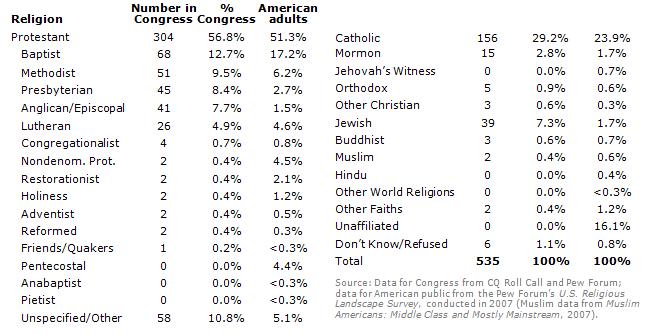By Pew Forum on Religion and Public Life

Many analysts described the November 2010 midterm elections as a sea change, with Republicans taking control of the U.S. House of Representatives and narrowing the Democratic majority in the Senate. But this political overhaul appears to have had little effect on the religious composition of Congress, which is similar to the religious makeup of the previous Congress and of the nation, according to an analysis by the Pew Research Center’s Forum on Religion & Public Life.
The 112th Congress, like the U.S. public, is majority Protestant and about a quarter Catholic. Baptists and Methodists are the largest Protestant denominations in the new Congress, just as they are in the country as a whole.
How the 112th congress compares with the American public
A few of the country’s smaller religious groups, including Episcopalians, Presbyterians and Jews, have greater numerical representation in Congress than in the general population. Some others, including Buddhists and Muslims, are represented in Congress in roughly equal proportion to their numbers in the adult U.S. population. And some small religious groups, such as Hindus and Jehovah’s Witnesses, are not represented at all in Congress.
Perhaps the greatest disparity between the religious makeup of Congress and the people it represents, however, is in the percentage of the unaffiliated – those who describe their religion as atheist, agnostic or “nothing in particular.” According to information gathered by CQ Roll Call and the Pew Forum, no members of Congress say they are unaffiliated. By contrast, about one-sixth of U.S. adults (16%) are not affiliated with any particular faith. Only six members of the 112th Congress (about 1%) do not specify a religious affiliation, which is similar to the percentage of the public that says they don’t know or refuses to specify their faith.1
These findings are based on a comparison of the religious affiliations of members of the new Congress with data on the U.S. public from the U.S. Religious Landscape Survey, conducted by the Pew Forum in 2007 among more than 35,000 U.S. adults. CQ Roll Call gathered information on the religious affiliations of members of Congress through questionnaires and follow-up phone calls to members’ offices. The Pew Forum supplemented that information with an extensive review of media reports on candidates in 2010 House and Senate races. It should be noted, however, that there is an important difference between a confidential telephone survey of a sample of U.S. adults and media inquiries about the religious identification of an elected official or candidate. Media inquiries may find fewer “unaffiliated” people because those inquiries are more public.
The New, 112th Congress
Of the 535 members of the new Congress, 304 – or 57% – are Protestants, which is slightly higher than the share of Protestants in the U.S. adult population (51%). Compared with the previous Congress, the 112th Congress has added 12 Protestants, an increase of roughly two percentage points.
Baptists remain the largest Protestant denominational family in Congress, essentially unchanged from the 111th Congress, though there are somewhat fewer self-described Baptists on Capitol Hill (13%) than in the national population (17%). Methodists have declined slightly in their proportion of Congress, dropping by six members, or about one percentage point. Nonetheless, Methodists still comprise a larger share of Congress (10%) than of the public (6%).
Some other Protestant groups also are overrepresented in Congress relative to their numbers in the general population. For instance, while fewer than 2% of American adults identify themselves as Episcopalians, about 8% of Congress is affiliated with the Episcopal Church. In addition, 8% of Congress is Presbyterian, about three times the percentage of American adults who say they are Presbyterians (3%).
Protestants who do not specify a particular denomination grew the most from the 111th to the 112th Congress, increasing their ranks by 19 members, to a total of 58. They now comprise 11% of Congress, up from 7% two years ago. The proportion of unspecified Protestants is nearly as high among incumbents (10%) as among newly elected members (13%). It is unclear whether any of these unspecified Protestants are affiliated with nondenominational churches; just two members of the 112th Congress specify that they belong to nondenominational Protestant churches.
If Protestants are not counted together but as separate denominations, then Catholics are the largest religious group in the 112th Congress, with 156 members. Compared with the previous Congress, their ranks have thinned by five members. Still, Catholics comprise about 29% of the House and Senate, compared with about one-quarter of the U.S. adult population (24%).
Jews, who make up about 2% of the U.S. adult population, account for 7% of Congress as a whole and 12% of the Senate. However, there are six fewer Jewish members in the 112th Congress than there were in the 111th, a one-percentage-point decline. Mormons also make up about 2% of the U.S. public and a slightly larger portion of Congress (nearly 3%). That figure is about the same as in the previous Congress; there are 15 Mormons in the 112th Congress, one more than previously.2
Some other small religious groups are about as numerically well-represented on Capitol Hill as in the general population. Muslims, who account for 0.6% of the U.S. adult population, make up 0.4% of Congress, while Buddhists make up 0.7% of the U.S. adult population and 0.6% of Congress. There are no Jehovah’s Witnesses, Hindus or people who practice other world religions in Congress; these groups each have a small presence (less than 1%) in the U.S. population as a whole.
Disclaimer: Articles featured on Oregon Report are the creation, responsibility and opinion of the authoring individual or organization which is featured at the top of every article.


